By Austin Knudsen
Montana is a state rich in shooting and hunting opportunities. In the last few years, my family and I have gotten into prairie dog hunting in the southeast part of the state in a big way. For the uninitiated, prairie dogs are a small rodent mammal species native to much of the western U.S.’s open prairies and mountain foothills. However, they aren’t native to the area of northeastern Montana where I come from, so I didn’t have any experience hunting them.
These critters are incredibly destructive to the range and habitat, and as far as most landowners are concerned, serve no useful purpose other than to destroy rangeland and take much needed feed from livestock.
Prairie dogs live in large colonies called “towns.” They dig huge holes/dens (which can injure livestock), eat every useful living plant in the vicinity, and sterilize the area around their dens of any productive plant life with their urine and manure.
On top of that, they’re prolific reproducers. Rabbits have nothing on these little varmints. This means that in some instances, you can have an uncontrolled prairie dog town with thousands of these pests, covering tens and sometime hundreds of acres.
Oh, did I mention that prairie dogs often carry and transmit the bubonic plague, too?
That means landowners with prairie dog infestations are often more than happy to let varmint hunters assist in controlling populations. And I’m here to tell you: prairie dog hunting might be the most fun I’ve ever had shooting. A big prairie dog can reach the size of a football, and with the right varmint bullet, you can get some real fireworks popping these little buggers. In a “virgin” prairie dog town full of uneducated pests, you can shoot for hours and burn up lots of ammunition.
In my experience, there are basically two methods to hunt prairie dogs . . .
Technique 1: Set up a couple of shooting tables, pull out your favorite long-range varmint rifle, sit in one spot for a couple hours and see who can make the longest distance kill.

Technique 2: Drive around with short-to-medium range varmint rifles poking out your 4×4 cab windows Mad Max style and blast away (assuming, of course, that the landowner has approved of this method).
I’ve done it both ways and both are a lot of fun. For Technique 1, the .223 Remington is a little underpowered, as shots past 400 yards and out to 800 yards and beyond are common. For long range shots on a small target like a prairie dog, I prefer the .22-250 Remington, .243 Winchester, 6.5 Creedmoor, or even .308 Winchester.
However, for the “drive around and shoot alot” Technique No. 2, you really only need two rifles: a .22 Long Rifle or .17 HMR for ranges inside 100 yards, and a .223 Remington for 100-300 yard shots. At those ranges, the little .223 round provides plenty of accuracy and “pop” on the rodent vermin.
Our annual prairie dog hunt has turned into a bit of an event involving a (sometimes motley) crew of friends and industry folks, most of whom opt for an AR-15 of some flavor. This includes my wife Christie, who has become absolutely deadly-accurate with her home brew AR.
I too used an AR for the first few years. However, I soon noticed that shooting at prairie dogs with an AR was giving me the bad habit of “machine gunning” after misses, rather than taking my time upfront and making good shots. Also, in 2021 I inadvertently ejected several pieces of empty .223 brass out of my AR and down into the dash defroster vent of my F-250.
This led to me having to completely remove my dash to fish out said brass so my climate control system would work properly.

Side note: use of brass catchers is now mandatory in my vehicle.
Thus, I began to toy with the idea of a hyper-accurate bolt action rifle chambered in .223 Remington.
Tools for the Trade
I’ve never owned a .223 Remington-chambered bolt gun, because frankly I never had much use for the .223 Remington for hunting. Hoplophobes screech about the scary AR-15 and its “high-powered” cartridge, but the .223 Remington is too anemic for my eastern Montana farm and ranch uses.
There are much better-performing coyote hunting cartridges out there — such as the aforementioned .22-250 Remington or .243 Winchester to name a few — and a bolt action .223 was just not something I ever needed.
But my mind changed for the reasons stated above, and there were only a few bolt gun manufacturers that stirred my soul and my interest. CZ is one of those manufacturers.
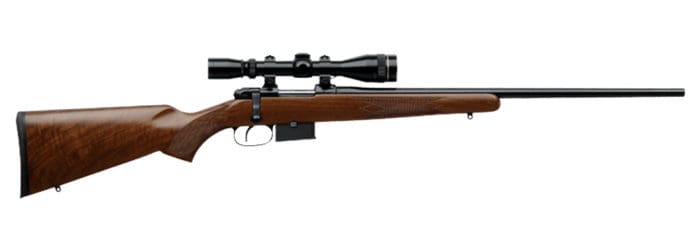
I’ve become a bit of a CZ fanboy. I own a couple of CZ’s absolutely beautiful square bridge Mauser model 550s: a .22-250 Remington Kevlar Varmint, and a .375 H&H American Safari. These CZ rifles were largely hand-finished and exhibit true old-world craftsmanship.
On top of that, they’re amazing shooters. While the CZ 550 is a pure Mauser copy, the 527 is simply a miniaturized 550. Discontinued in 2014, the 527 is a short-action, controlled round feed, full-length claw extractor action mated with a cold hammer forged barrel, a novel detachable 5-round magazine, and CZ’s awesome push-forward single set trigger.
The Varmint version sported a heavy 26-inch bull barrel, and could be had in either a gray synthetic or traditional walnut stock. There were a couple sporter versions too. My advice: if you find a 527, buy it. They are getting scarce.
By chance, I walked into Capital Sports in Helena, Montana last winter and spotted in the used rifle rack a very good condition CZ 527 Varmint with a walnut stock chambered in .223 Rem. It was literally the exact rifle I had my eye out for, and I pounced.
A good thing, too. No sooner had I grabbed it and started filling out the form 4473, than another customer walked into the gun section and said “I heard you have a CZ .223 in here, and I want it.” Sorry, buddy. I’d rather be lucky than good.
Upon getting my newly acquired 527 home, I decided it was going to be a polite rifle. With as many prairie dog shooters as we often have banging away with .223s inside the confines of a vehicle cab, I’ve decided that suppressors are a must. In the summer heat of southeastern Montana, wearing hearing protection earmuffs all day can get tiresome and uncomfortable. And it seems like every time I think it’s safe to slip my hearing protection off for just a moment, that’s the moment I get muzzle blasted by someone’s rifle.
The only way to avoid this is to equip the rifles with suppressors. Yes, suppressors are expensive (though becoming less so). Yes, it’s a pain dealing with the ATF. Yes, the wait time is ridiculous, especially under Biden’s ATF. Yes, it’s stupid that you can’t just buy what amounts to a muffler over the counter. However, until federal law changes, it is what it is.
So, I called Dennis Erhardt at Frontier Gun Shop in Helena, who for a very reasonable price and quick turnaround time, threaded my 527 barrel for my Elite Iron STFU rifle suppressor.
Shameless plug: Elite Iron is a wonderful Montana company that makes the toughest, military full-auto rated rifle suppressors in the world, and founder/owner Dale Poling is a friend and amazing long-range rifle shooter.

The next step for my 527 was to mount a scope on it. In prairie dog hunting, higher magnification is advantageous (as in, you’ll want more than a 3-9x). I’d already decided I was going to mount an old Simmons Whitetailer 6-18x scope I had laying around. This scope was purchased more than a decade ago from Midway USA for such a bargain price that I bought two.
While definitely a cheap scope with a too-thick duplex reticle, I’d had it mounted on a coyote rifle that banged around in the hills and in my pickup cab for years, and it had proven itself reliable.
The 527 receiver comes pre-machined for CZ’s proprietary scope rings. The problem was, I couldn’t find CZ rings tall enough for the Simmons’ large objective bell to clear the rifle barrel. A little internet sleuthing, and a solution presented itself: a company called Diversified Innovative Products manufactures a Picatinny rail (reasonably priced, I might add) for the CZ 527 that attaches to the top of the 527’s receiver.
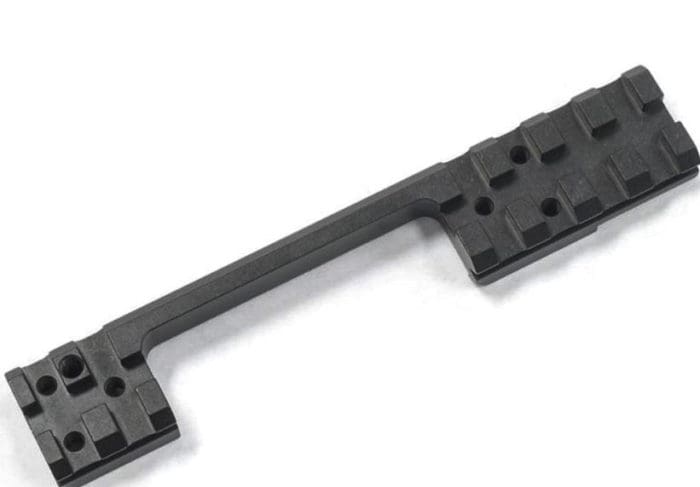
This rail, once installed, allows any Picatinny or Weaver style scope ring to be used, and greatly increased my scope mounting options.
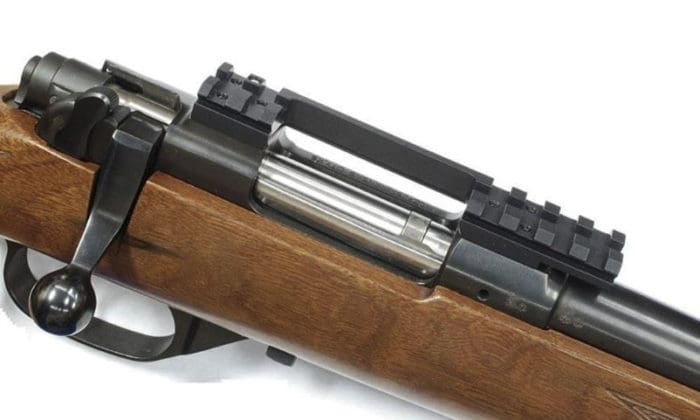
Once installed, the DIP Pic rail gave me more height clearance, and I was able to easily mount my optic using much more available Weaver-style scope rings. I have absolutely no affiliation with anyone at Diversified Innovative Products, but this is a great product.
Finally, I needed ammo for my new prairie dog slayer. The problem: this was right in the middle of The Great Joe Biden Ammo and Components Drought of 2021, and I wasn’t going to shoot whatever store-bought factory FMJ ammo I might luck into 20 rounds at a time.
A rifle like this requires a finely crafted handload. I had plenty of .223 brass, and luckily I had squirreled away enough small rifle primers, which were then — and are still now — unobtainium. I purchased 1,000 bulk blemished 55 grain jacketed soft point bullets from Midway, and now just needed to work up a load.
Powder was my real problem. I’d gotten a good handload recipe from a friend: 25 grains of RamShot TAC behind a 55 grain Hornady V-Max. However, TAC was absolutely impossible to find anywhere in Montana at the time, and I only had one pound of it on hand. I loaded it all up, but had to come up with another handload, using a different powder that I had on hand or could actually acquire.
I had two options for plentiful powders: IMR 4198 and IMR 4064. For this load development, I tested three different loads: the above-mentioned 25 grains of TAC and a 55 grain V-Max, 20 grains of IMR 4198 behind a 55 grain jacketed soft point, and 25 grains of IMR 4064 behind the same 55 grain jacketed soft point.

All three loads grouped well from the 527 at 100 yards, but the TAC load and the IMR 4064 load were the definite accuracy winners and were the two loads I ended using on the prairie dog hunt.

Nut Cuttin’
So, with glass mounted, suppressor affixed, and ammunition loaded: my rifle, my family, and I hooked up the camper and headed to parts unknown in southeastern Montana to meet up with our compatriots for a 4-day prairie dog shooting extravaganza.
The mid-June weather cooperated. The week before our hunt had seen cool temperatures and rain, which was perfect, as we didn’t need to worry about accidentally sparking a prairie fire with our vehicles’ catalytic converters. The week of our hunt saw sunny skies, with morning temps in the high 60s and 70s and afternoons and evenings of 80s and low 90s…absolutely perfect prairie dog conditions.
You want to know the best thing about prairie dog hunting? You don’t have to get up before dawn. We usually get up at 7:00 or 8:00am, cook a good breakfast, drink some coffee, make a game plan for the day, figure out who’s driving and riding in what vehicles, and amble out of camp by 9:00 or 10:00.
We usually end up spending all day shooting, with lunch coming out of a packed cooler. We’ve also learned not to quit too early: the absolute best prairie dog shooting comes right as the sun is setting. For whatever reason, these dim critters almost seem to attack when the sun starts getting low. On an uneducated town, it’s not uncommon to have multiple prairie dogs on one den, standing up to see what all the ruckus is about.
Sometimes, they even line up in your cross hairs. Multiple targets, anyone?

It’s the People
In the last few years, our prairie dog hunting camp has had a colorful cast of characters. At our 2021 camp, Mark Oliva and Nephi Cole with the National Shooting Sports Foundation (NSSF), Sean Davis of the conservative news site The Federalist, and Wyoming Arms co-owners John Burns and Jeff Leisy joined us for a few days. These gentlemen ended up doing some long-range shooting with Wyoming Arms’ high-end ARs.
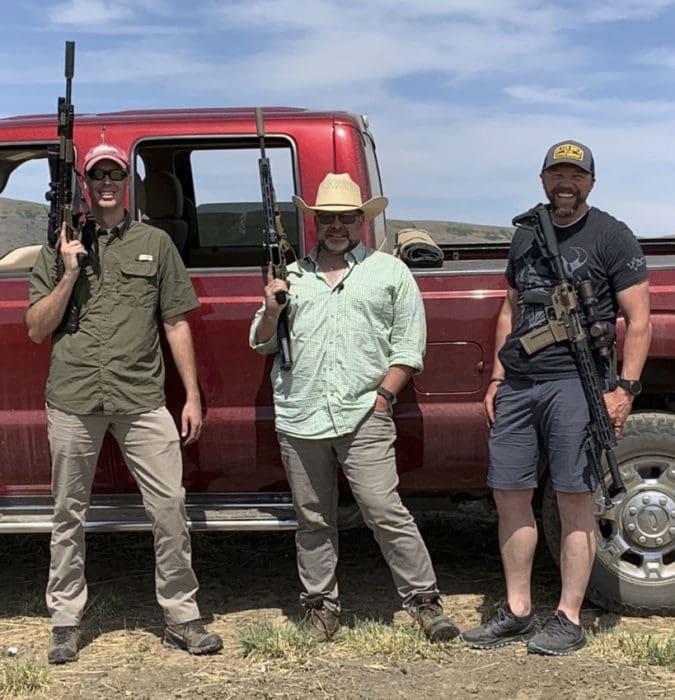
At our 2022 camp, good friend Don Edwards (of Greenline Tactical fame) asked if he could bring a buddy along. I trust Don, so of course I said yes. The new friend ended up being Aaron Quinn, owner of Cobalt Kinetics. Aaron and Don showed up with a truck full of toys (Don is the night vision guy in the U.S., and always has a vehicle full of NODs).
Don knows that I’m a .243/6mm believer, and subsequently put me behind one of Cobalt’s wicked-cool 6mm ARC rifles. I’d never spent any time with the cartridge. Don, Aaron, my wife and I ended up sitting on the edge of a prairie dog town for an afternoon, testing out Cobalt’s 6mm ARC rifles (and a high definition video camera) at 600+ yards. How can it possibly get any cooler?

Despite all the cool AR kit, I couldn’t have been happier with my CZ 527 for the hunt. While I wasn’t able to rapid fire or get follow-up shots as fast as some of the others shooting ARs, the bolt gun made me slow down and be more precise.
That isn’t a condemnation of ARs…quite the opposite. It’s a condemnation of myself. For whatever reason, ARs make me want to shoot fast. It’s probably from years of shooting in 3-Gun competitions. But having a bolt action rifle in my hands makes me slow down and make my shots count.
I’ve noticed the same phenomenon shooting action pistol over the years; with any of my competition semi-auto pistols in my hands, I want to shoot fast. But with my old S&W .357 revolver, I’ll slow down, aim, and make that one shot count. The CZ 527 has the same effect on me. I take an extra second, get a good hold, and touch the CZ’s fantastic set trigger, more often than not to success.

Being a good shot at camp is important to me, especially considering the guy riding in my pickup, looking over my shoulder and watching me shoot for the last couple years’ prairie dog hunting camps . . .
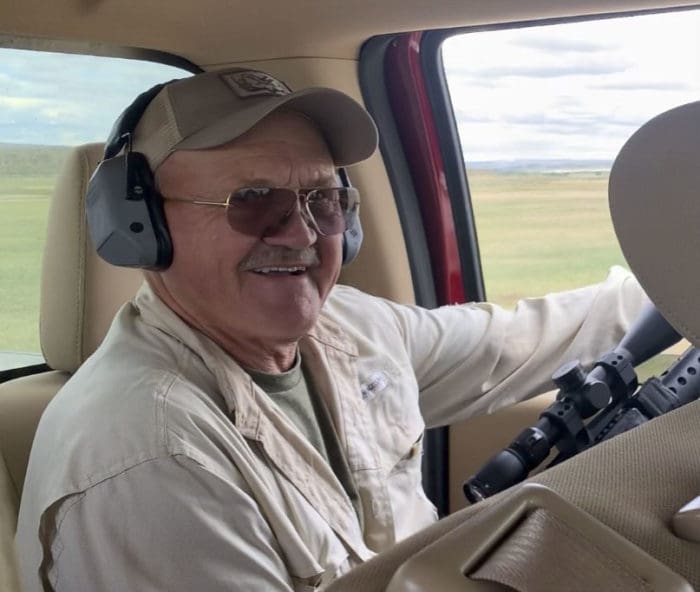
I’m still not sure how it happened, but somehow Jerry Miculek ended up in our prairie dog hunting camp for the last couple years. Not only Jerry, but his wife Kay (Clark) Miculek, too. If you don’t know who these two are, stop reading now, Google them, and come back. Jerry and Kay Miculek are absolute shooting legends, and are both multi-discipline decorated championship shooters.
Jerry has been one of my heroes for decades. I’ve been a Smith & Wesson revolver shooter since I was 16, and I’ve been watching his “impossible shots” segments on Shooting USA and YouTube for years. Jerry Miculek is like Michael Jordan to me.
Never in a million years did I imagine that I’d get to meet him and his amazing family, let alone hang out and shoot with them. So, if I told you that I didn’t squeal like a teenage girl at a Jonas Brothers concert after I got my first phone call from Jerry asking me about prairie dog shooting in Montana, I’d be lying. To make it even better, Jerry and Kay are wonderful people. They say “be careful meeting your heroes,” but I’m thrilled to report that Jerry is one of the finest, humblest gentlemen I’ve ever met. And Kay is as fine a lady as I’ve ever had the opportunity to be around.
Jerry and Kay are also prairie dog shooting machines. These two like to shoot, and they like to shoot in high volume. Just to be sporting, Jerry started last year’s camp shooting an AR pistol caliber carbine (PCC) chambered in 9mm, firing a bucket full of Jerry’s “special” handloads. These handloads consisted of a 90 grain Hornady XTP 9mm bullet pushed at a ridiculous velocity by some mystery bulk military machine gun powder Jerry’s had on hand for years.
Those loads coming out of his PCC barrel sounded like a fighter jet flying overhead, and the results on prairie dogs inside of 100 yards were spectacular, to say the least. (I know you’re all imagining Jerry sending a prairie dog flying and saying “Hey-ohhhh”- it’s true he does it).
Kay Miculek is an absolute T-800 Terminator behind her AR-15, and she is literally one of the best long-range rifle shooters I have ever seen. Truthfully, the most fun we had was having Jerry and Kay in the same vehicle, watching them compete with each other for prairie dogs.
Two years ago, my wife, my son and I took an impromptu lesson from Kay one afternoon just on improvised shooting positions from inside a vehicle. This might sound a bit silly, but I’m convinced in today’s world, this is absolutely an applicable skill. Kay is a smaller lady, and to watch her contort herself into a rock-solid shooting position in any given passenger seat in my pickup was impressive. Especially when she made kill shots on football size targets at 250 yards, as regular as a Singer sewing machine makes stitches.
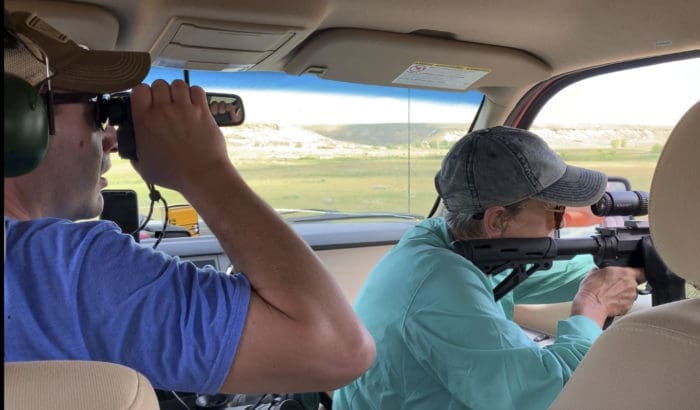
My 12 year old son hadn’t done much long range rifle shooting, let alone with an AR. So it was pretty awesome for my wife and me to watch the Kay Miculek giving him a one-on-one lesson, with her personal AR-15. She had him zapping prairie dogs at 200 yards within 20 minutes, to his (and her) delight.
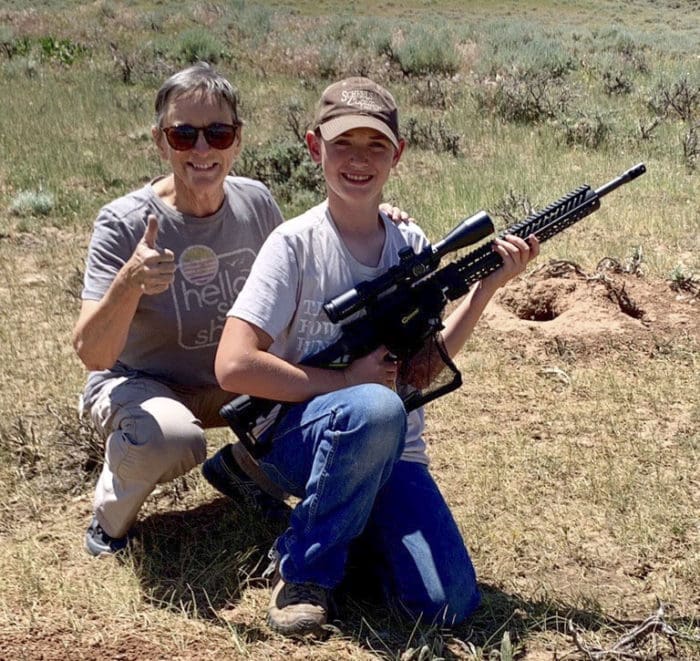
In the end, I’m plum tickled with my CZ 527. It’s an absolute tack driver, and a ton of fun to shoot. And there is something to be said about being the guy in camp with something novel. This is especially true when almost everyone else in camp is shooting an AR-15 of some flavor, and I’m one of the Fudds who elects to use a walnut-and-blue-steel bolt gun. Everyone has seen a million ARs. But there’s nothing quite like a beautiful bolt action…

I’ve been hunting and shooting my entire life. I’ve hunted pretty much everything Montana has to offer for large and small game. And I can legitimately say that prairie dog hunting is probably the most fun I’ve ever had shooting.
At our last camp, the landowner came over and had supper and a drink with us on the last night. He asked us how many prairie dogs we thought we had killed, as prairie dogs cost him a huge amount of money every year in lost pasture forage for his cattle.
His question legitimately set us back, because none of us had been keeping score; we’d just been busy shooting. So we sat down and conservatively estimated that among all of us in camp, we had probably killed somewhere between 8,000 and 10,000 (you read that right) prairie dogs cumulatively in the course of the week.
Jerry Miculek, being Jerry, is a man of few words. Rather than answer the landowner’s question directly, he simply walked outside. After 30 seconds or so, Jerry came back into the house carrying a 5-gallon bucket full of the fired .223 brass he alone had produced in the last few days. “Does this answer your question?” Jerry asked, in his Cajun lilt. The landowner’s eyes bugged out, as he was genuinely stunned and thrilled.
Our annual family prairie dog hunting camp in southeastern Montana has turned into something more special than I ever could have imagined. New friends have been made, lessons have been learned, lifelong friendships have been formed, terminal ballistics and national politics have been discussed, hunting stories have been told, and whiskey may or may not have been sipped.

The 2022 Montana Prairie Dog Hunting Camp: Kay & Jerry Miculek, Ryan Morgan, Aaron Quinn, Don Edwards, the incomparable E.J. Redding, Becky & Seth Berglee, Mr. & Mrs. Knudsen, and their family. Pew pew, my friends.And that, friends, is what it’s all about, whether you’re shooting a bolt action or an AR.
Austin Knudsen is the Attorney General of Montana.





cz will make an ar.
Hey! Wow! .223 Rem/5.56 mm is good for at least one thing. Calm down. I have at least 1/2 dozen. I’ve used them hunting and in DGU. Just remember they are not a .308/7.62 NATO. Or, 7.62X39. It can’t be. It’s smaller. Physics says it can’t be better. Don’t believe me? Ask Newton and Einstein.
Not that I doubt you but, just to because I was curious as to their opinions I sent an e-mail to Mr. Newton and Mr. Einstein. I will let you know what they had to say when they reply.
Rusty, please offer them my complements them. I’d like to meet them at their convenience.
I’ve been using .223 Remington Varmint Special for California ground squirrels for years. 20.5 grains of IMR4198 behind a Hornady 55 grain Vmax or SPX bullet still gives 5 round groups in 3/8 groups at 100 yards.
One of the mysteries of reloading. What works in your gun may not work in another.
I use 25.5g of AR2206H (repackaged by Hogden) behind 55g Sierra “Roo Load” projectiles and it seems to shoot well out of the 3 guns I use it in.
Yes, it always is: Your mileage may vary when it comes to reloading. But I have pretty consistent accuracy with the IMR4198 with 1 in 12 or 1 in 10 twist barrels.
Things must have changed because I used to P dog hunt, but ranchers charged us 100 bucks a day to hunt their property. X3 guys was some good coin to get rid of pests.
I used a.17 HMR (way cheaper than 223) but I did also poke out 400 yards with my 204.
Bob, a lot of people pay to hunt lots of different game. Why should varmints be any different? I never knew a farmer that wouldn’t make money of his land. Especially, if it benefited the other side of the coin. That’s like shoveling shit out of the barn and selling it for fertilizer.
Reminds me of shooting rats at the dump when I was a kid. There may be a trip to Montana in my future!
I wonder what Hank Jr. would say. Still I bet the rats at the dump are illegal today. I don’t know, but think about that. The city, or county could charge a nominal fee for citizens to shoot rats at transfer stations. I understand that’s a garbage dump today. A thing that benefits everyone. Except, the rats. There is that.
I got a BIL in Montana. He uses a Truck as a game blind, also.
For those of us that missed out on the CZ 527, is there any word about how the CZ 600 compares? All I know about them is that there’s a recall in effect.
Good read.
An attorney I used to work with loved to hunt PD’s in North Texas at over 1000 yards, purely for the challenge. (His other passion was hunting elephants in Africa. Took his last one, on foot, when he was in his 80’s.)
He had a pickup specially modified just for PD hunting: massive custom concrete shooting bench built into the bed, and hydraulic legs that would jack the truck up (so that it was not resting on its tires) and level it once you were in position.
He was just as anal with his hand loads, and had the best glass he could get.
While I am a native Montanan and don’t live but an hour from the Montana border, I think shooting wild boar from a helicopter or any other motorized vehicle would be a helluva lot funner. Not that prairie dogs are any less destructive, it’s just entertainment value I’m considering.
Speaking of a fine time hunting rodents..
I have thoroughly enjoyed watching this video of an upper class brit hunting Nutria with a cajun in a Louisiana swamp. I must have watched it 20 times and it never gets old.
My uncle had a ranch a little west of Wichita Falls, in Tejas. He literally lost cattle from broken legs from stepping in prairie dog holes. The little bastards could infest a pasture in so little time, it was amazing. He used to organize prairie dog hunts about twice a year.
When I got older, like in middle school, I got to participate a couple of times.
Shooting prairie dogs with a bolt action .22 at out to 100 yards will humble you, quickly. I actually hit a few.
All that effort and expense and you top with a Simmons $100 scope? You lost me there. I’d take any 3-9 quality scope in a heartbeat.
Like buying a Corvette and throwing the cheapest, junkiest Chinese tires on it.
Gasoline mixed with diesel fuel
What do you call a prairie dog on fire?
Pickle relish. Mustard and suar kraut please.
Be careful, possum! Them prairie dogs is your cousins! Pogo would be disappointed in you.
What a wonderful article this was!
I sent the link to this story to my brother who has gone to Montana for this purpose. Here was his response.
On my first prairie dog hunt, we came across a prairie-dog town that had been ravaged only hours earlier by another hunting group. I was walking through the carnage when I came across a couple of shell-shocked cubs just standing at the top of their den hole, their parents turned into splatter nearby. I was standing just six feet away but their youth and shell shock rendered them unable to flee down the hole. So I shot them both with my 9 mm.
That’s such a sweet story.